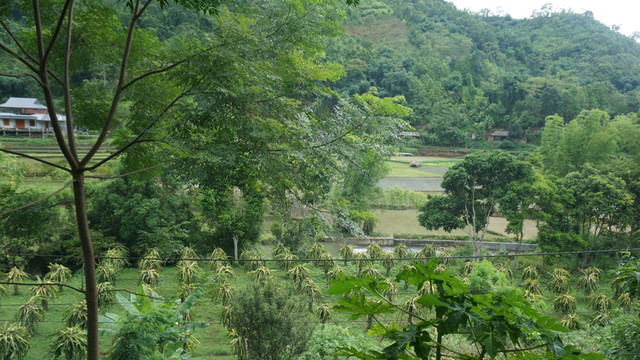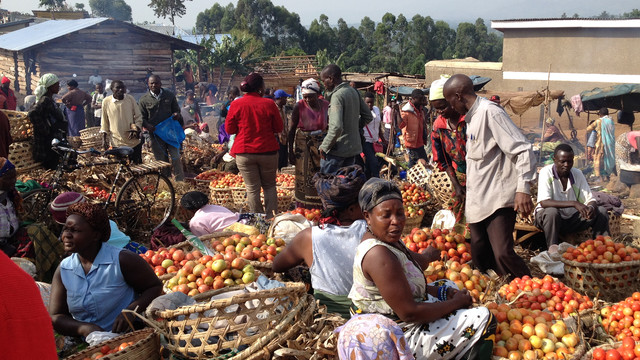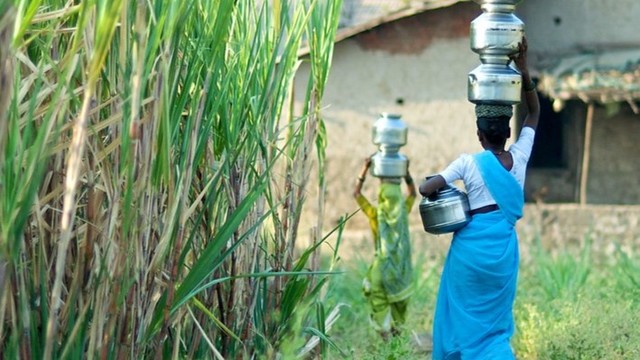Farming on the city's periphery to enhance resilience
Farming land on the edge of the Gorakhpur, India, can help boost the city's flood defences, support livelihoods and reduce migration, finds guest blogger Nivedita Mani.


Women harvesting brinjal near the Indian city of Gorakhpur. Peri-urban agriculture helps to ensure local food supplies, especially of fruit and vegetables (Photo: Gorakhpur Environmental Action Group)
Rapid urbanisation in the Indian city of Gorakhpur has created strong pressure to convert agricultural land. Land is wanted for industrial, residential and commercial use, as well as for infrastructure development.
Much of this land-use change is occurring around the city and adjacent to rural areas that are described as 'peri-urban'. But maintaining this farm land is crucial for protecting the city from climate change, as the Gorakhpur Environmental Action Group (GEAG) has shown.
Gorakhpur faces particular problems in relation to its peri-urban area. There is intense pressure on resources, a lack of provision of basic need services such as water supply and sewerage management, the degradation of adjacent farmland and hence, a reduction in the amount of open, green areas which are important for maintaining the city's buffering capacity against floods and waterlogging.
More importantly, the governance and management of peri-urban areas are often neglected by both rural and urban administrators. These areas lie beyond urban administrative boundaries and the rural administrative set-up does not have the human or financial resources to upgrade infrastructure and develop appropriate plans and procedures.
GEAG has been promoting resilient agriculture in the peri-urban area. This is central to building resilience to climate change for the entire urban area. The initiative started with 30 small and marginal farmers who have become 'models' by showing that farming can give them resilient and profitable livelihoods.
As a result 619 other farmers in the area are following the footsteps of these 30 model farmers. We aim to reach 930 farmers by the end of 2015. The interventions have had direct and indirect impacts on a population of 18,000.
Peri-urban agriculture represents a practical mechanism for diversifying urban livelihoods for poor and marginalised communities, ensuring local food supplies, particularly vegetables and fruits, and conserving open areas that serve as flood buffers.
The climate-resilient agricultural practices and innovative methods of farming have motivated the farmers to sustain their interest in agriculture and to leave the land use patterns unchanged. The underlying strategy is to make peri-urban farming economically viable among the farmers and demonstrate new techniques of farming which are climate-resilient.
Climate-resilient agriculture, based on the principles of integrating livestock, the household and agriculture, is promoted as a way to enhance the diversity, complexity and recycling processes in farming systems.
This has helped the farming communities become more robust and more flood-resilient by minimising the chances of losses. Increasing diversity in agriculture means increasing the number of elements performing one function. Beyond the crops, this can include sub-systems in the farm such as aquaculture ponds, orchards/kitchen gardens, livestock and poultry. Each of these elements can perform multiple functions, enhancing complexity and providing flexibility to the overall farm system.
The farmers have also adopted recycling processes in farm sub systems, reducing the need for external inputs. Farmers use a range of practices including reducing external bio-inputs, growing appropriate crop varieties, employing space and time management, seed banking, land shaping and potable nursery systems.
Text message-based weather warnings sent by GEAG help the farmers to take appropriate decisions. In response to the geographical conditions of the area and frequent flood events, farmers have adopted innovative farming practices to sustain their livelihoods.
I am a small-landholding farmer in the peri-urban village of Gorakhpur. My land is in a low lying area and during heavy rainfall, my entire crops used to get submerged in the waters. Also, since I used to grow only 1-2 crops, I used to incur heavy losses.
I have now learnt from climate resilient farming practices and I am able to grow crops even in waterlogged fields. I grow 19 types of crops now which not only add diversity to my farm, but also help in diversifying the income sources. I am thinking of increasing the agriculture farm area as it has started giving me good income.
-- Mahajan Yadav, farmer, Village Semra Devi Prasad, Gorakhpur
The peri-urban agriculture in Gorakhpur has been a successful attempt to reduce migration by desperate farmers as it has generated hope in farming. Climate resilient agricultural practices have helped in reducing input costs, boosting the net gains.
It has also contributed to the enhanced livelihood security of vulnerable groups and ensured food security for the urban poor.
Unchanged land use patterns and conservation of agricultural land in peri-urban areas is helping in increasing the flood buffering capacity of the city on the whole.
Nivedita Mani (niveditamani@gmail.com) is a researcher with Gorakhpur Environmental Action Group's Asian Cities Climate Change Resilience Network ACCCRN) project in Gorakhpur.


